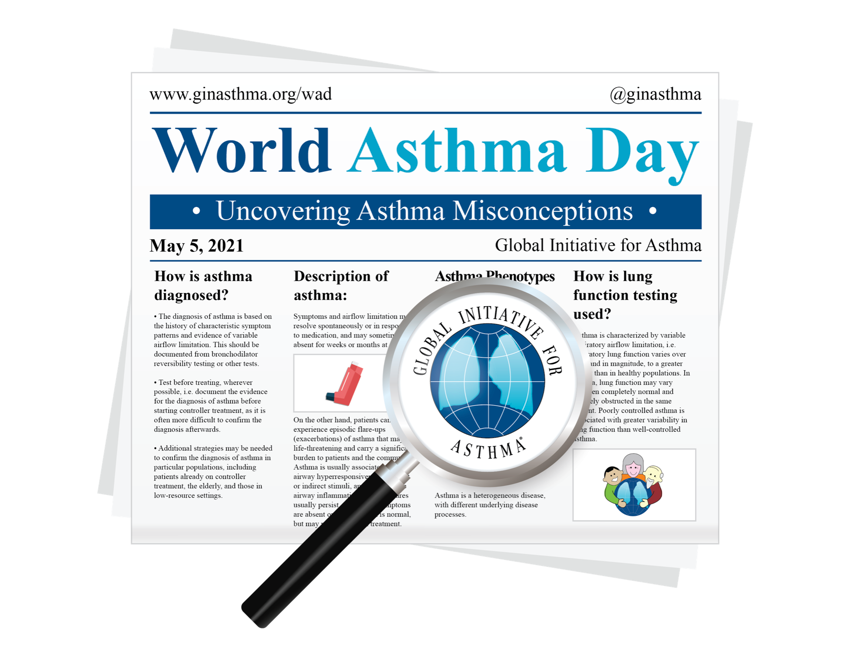May is asthma awareness month and World Asthma Day is celebrated annually on the first Tuesday of May.
Asthma is one of the most common chronic diseases throughout life and is recognized as a Public Health problem, with a huge impact on the consumption of health resources. According to the 2010 National Asthma Prevalence Survey, it affects 6.8% of the population residing in Portugal, all age groups. Although it is a myth that asthma is a paediatric disease, it does have a higher prevalence and morbidity in children and adolescents, although higher mortality in the elderly.
Asthma is a frequent, heterogeneous chronic disease, described based on the history of respiratory symptoms such as wheezing, dyspnoea, chest tightness and cough, which vary in intensity and over time, associated with variable bronchial obstruction that should be examined, at a minimum, by spirometry with bronchodilation test.
The variability of symptoms and bronchial obstruction can be triggered by exercise, allergens or exposure to inhaled irritants, including climate change or viral respiratory infections, drugs, pollution and tobacco smoke.
There are 3 huge challenges facing the clinician regarding children with asthma: making the correct diagnosis and periodically reviewing it, researching and diagnosing comorbidities and winning over the child and family for adherence to therapy and the monitoring plan.
Particular attention should be paid to the identification of risk factors for worsening asthma, the so-called “asthma attacks”. A study carried out in the UK found a high prevalence of acute asthma in children of preschool age (below 5 years of age), in all therapeutic steps. In all age groups, non-adherence to the therapeutic plan was a risk factor for worsening the condition.
Talking about asthma in paediatrics is of particular interest because, in addition to the diagnostic challenge, it can present itself in many ways, especially in preschool and adolescent groups. Some differential diagnoses can mimic or be mistakenly diagnosed as asthma.
In 2021, the World Health Organization (OMS), through the Global Initiative for Asthma (GINA), defined as priorities to address the common misconceptions of asthma, which include:
- Asthma is a child's disease that goes away with age;
- Asthma is an infectious disease;
- Asthma sufferers should not exercise;
- Asthma is only controllable with high doses of corticosteroids.
The truth is:
- Asthma occurs at any age (children, adolescents, adults and the elderly);
- Asthma is not infectious. However, viral respiratory infections (such as colds and flu) can trigger asthma. In children, asthma is often associated with allergy. When it starts in adulthood, asthma is less often allergic;
- In well-controlled asthma, the person with asthma is capable of exercising, and even practicing highly competitive sports;
- Asthma is most often controllable with low dose inhaled corticosteroids.
The main objectives of asthma therapy and monitoring plan are to control symptoms and reduce the risk of exacerbations, progressive bronchial obstruction and adverse effects of drugs and the diagnosis and control of comorbidities. Control therapy includes pharmacological steps, which require an accurate assessment of the disease and patients, and non-pharmacological therapy, which includes environmental control, physical activity, exercise and diet.
Finally, in addition to reviewing asthma symptoms and treatment, it should be periodically assessed whether the diagnosis of asthma remains appropriate throughout the clinical follow-up and update the therapeutic action plan at each consultation.

Teresa Bandeira, Paediatrician, MD, PhD
Paediatric Pulmonology Unit;
Paediatrics Service. Department of Paediatrics, HSM, CHULN, FM-UL, CAML

References:
https://www.cdc.gov/asthma/world_asthma_day.htm
Hoskins G, McCowan C, Neville RG, et al. Risk factors and costs associated with an asthma attack. Thorax 2000; 55:19-24.
National Programme for Respiratory Diseases. DGS


